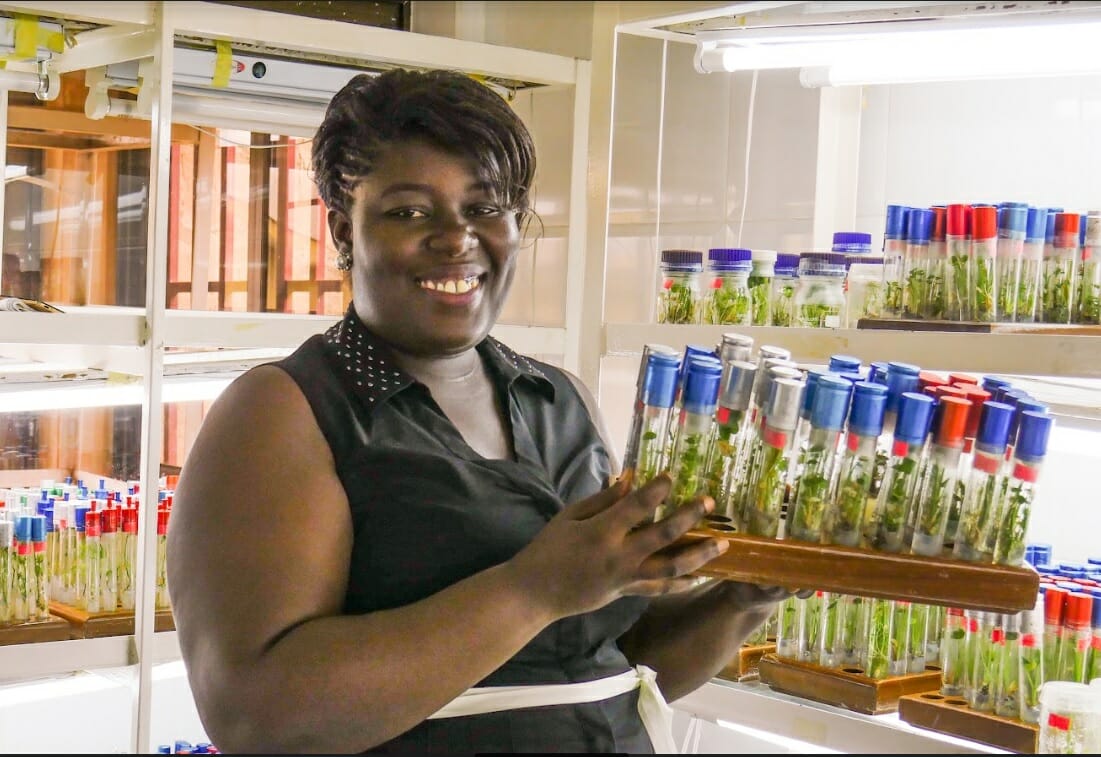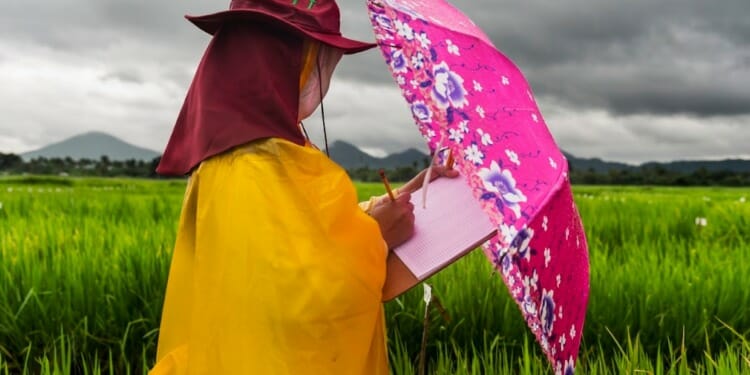In the bleak landscape of COP26 developments filled with blah-blah as Greta Thunberg so aptly put it, it’s good news to be able to report a concrete result: Serious emergency funding is finally on the way for genebanks. The Crop Trust and the Plant Treaty Secretariat announced the launching today* of an Emergency Reserve to provide a financial lifeline to genebanks facing urgent threats to their precious contents. The Reserve, which is the first of its kind, will respond to urgent requests from genebanks in low- and middle-income countries to prevent catastrophic loss of their collections.
This is very good news for all of us – not just the developing world. The less crop diversity there is within our global food system, the more our food is vulnerable to the impacts of climate change and other challenges. Genebanks, where thousands of crop varieties are stored for the future, contain the diversity required to build a climate-resilient food system.
“The launch of the Emergency Reserve is a major step forward in our fight for a climate-resilient future for food”, said Stefan Schmitz, Executive Director of the Crop Trust. “Genebanks around the world are facing crises on multiple fronts, from extreme weather events to the global pandemic and political instability. It is clear that further action is needed to prevent these forces from causing the devastating impact of permanently losing invaluable crop diversity. The Emergency Reserve provides a solution to this, and will be a lifeline for genebanks.”

For decades, genebanks have been forgotten, relegated to the sidelines, the subject of attention only from a few – very few – bio-scientists who for most people looked very much like obsessed, crazed individuals pursuing incomprehensible objectives. And while some efforts had been made, middle and low-income countries were totally forgotten. In those places without any kind of funding and no interest from the “global north”, the only custodians of crop diversity were local farmers, generally small farmers, indigenous people living in remote places, still producing crops like their ancestors had done over the centuries.
This is perhaps the best-kept secret about bio-diversity: the key role of genebanks for the continued existence of humanity and civilization. Without them, our fight for survival on this planet is doomed to failure, perhaps not immediately, but for sure in the long run. Genebanks are special places – very expensive to maintain because of two factors that are key in setting them up: (1) continuous refrigeration and monitoring, and (2) security from hacks and other ill-intentioned individuals. It sounds abstruse, why would we need to keep on reserve the seeds of crops we don’t use anymore or that very few farmers use in some remote corner of the world?
Disclosure: Thirty years ago, in my work at FAO, the UN specialized agency for food and agriculture, I came across a fellow worker, a woman bio-scientist from Norway, thin as a wire and determined to save crop seeds from disappearing. She was part of the CGIAR’s efforts to establish crop collections – the CGIAR is a network of 15 top-class research centers established 50 years ago – and I was struck by her absolute dedication.
At the time when I got to know her (it was the late 1980s), she was already near retirement, she had spent a lifetime fighting for the establishment of genebanks starting right after the end of World War II. She worked on establishing the Svalbard Global Seed Vault supported by the Global Crop Diversity Trust, known as the Crop Trust – an international organization that supports the conservation of plant genetic resources in genebanks, and their use for food and nutritional security. Her lifetime goal was to secure genebanks, finding the needed financing to maintain them (refrigeration and security are expensive, especially when needed on a 24/24 basis).

Of course, she and the CGIAR weren’t the only ones at the forefront of the fight to save ancient, forgotten crops. Normal people, non-scientists, were also working hard toward the same goal in developing countries. In India, in particular, I remember there were some remarkable leaders (often women) obtaining concrete results at the grassroots level with an alternative strategy: Support local communities in their efforts to maintain ancient crop seeds. After all, small farmers steeped in local traditions were often the best custodians of crop diversity. But they too needed genebanks to secure seeds over time.
The International Plant Treaty: A major strategy in the fight to conserve biodiversity
FAO had a few aid projects to assist local communities in setting their own crop seed conservation systems but in the end, the most fruitful strategy was to set up an international plant treaty to try and involve more directly the (distracted) “global north” in the fight for crop diversity conservation. On November 3, 2001 – twenty years ago – The International Treaty on Plant Genetic Resources for Food and Agriculture was adopted by the Thirty-First Session of the FAO Conference in Rome.
The Treaty recognized the enormous contribution of farmers to the diversity of crops that feed the world and aimed to:
- establish a global system to provide farmers, plant breeders and scientists with access to plant genetic materials; and,
- ensure that recipients share benefits they derive from the use of these genetic materials with the countries where they have been originated.
In practice, the Treaty enabled a wide range of useful activities. And here is where the Crop Trust comes in. The Crop Trust is recognized as an essential component of the funding strategy of the Treaty itself. It cemented the special status of the CGIAR’s in-trust crop collections, ensuring these would continue to be available to all. But it went much further than that. It declared that 64 of our most important crops – which together account for 80% of humanity’s food supply – would be brought into the same multilateral system, along with many of their wild relatives. All contracting parties would make their collections of this diversity available to everyone.
Under the Plant Treaty, breeders can easily obtain and work with material of these crop families from more than 130 countries. In many cases, they will do something innovative with it, such as create a new variety by combining lines from different parts of the world. Anyone who does so agrees that they will, in turn, make the derived variety freely available – or if they use it to develop a commercial product, that they will pay a percentage of profits into a special benefit-sharing fund.
The key role of the new Emergency Reserve
Now, finally, with the setting up of the “Emergency Reserve”, an important missing piece is put into place and the Treaty’s two main objectives might be said to be closer to achievement. The Emergency Reserve comes at a critical time – as so often underlined by COP26 participants – in our fight against Climate change while the global pandemic, pest and pathogen outbreaks, and political instability are posing ever-increasing threats to the security and maintenance of genebanks around the world.
The role of the Emergency Reserve is to provide vital short-term funding for genebanks to ensure they can respond swiftly to emergency situations. Since 2005, the Crop Trust has stepped in on a number of occasions to help genebanks around the world facing emergency situations. This has included contributing to international efforts to preserve thousands of seeds whose survival was threatened by the civil war in Syria in 2011, as well as providing funds to the Philippines national genebank in 2019 to restore its seed drying facility and to the national genebank in Yemen to replace its generator.
The Plant Treaty, which currently has 149 Contracting Parties, establishes a multilateral mechanism to exchange plant diversity for food security and sustainable agriculture around the world. Since 2007, more than 5.4 million samples of plant material have been transferred from national and international genebanks through the Treaty’s Multilateral System of Access and Benefit-sharing, including to adapt crops to climate change.
This new Reserve will provide a specific pot of funding to allow this work to continue reaching at-risk genebanks, specifically targeting those in low- and middle-income countries.
Two donors have come forward already to support the initiative: Italy and Norway. A significant part of the initial capitalization of the Emergency Reserve was made possible through financial support provided by Norway for the Crop Trust’s 10-year project, ‘Biodiversity for Opportunities, Livelihoods and Development’ (BOLD). The aim is to strengthen food and nutritional security worldwide by supporting the conservation of crop diversity in genebanks and its use in farmers’ fields. BOLD funded in 2021 with $58 million is a continuation of past efforts: It builds on the work and achievements of the decade-long Crop Wild Relatives Project (2011- 2021).
We can leave the last word to Kent Nnadozie, Plant Treaty Secretary who commented: “We live in an interconnected world. Losing a unique collection of plant genetic diversity in one country today means losing future opportunities of breeding a plant variety that will be adapted to changing environments and needs. Genebanks, which hold the key to our agricultural future, contain a treasure trove of traits we can harness to build more resilient crops, are themselves under threat.”
This is the point to remember: If genebanks disappear, so will our life on earth as we know it.
* The Emergency Reserve will be announced during the event It Starts With A Seed: Adapting Agriculture to Climate Change, part of the Global Landscapes Forum Climate Conference occurring alongside COP26.
Editor’s Note: The opinions expressed here by Impakter.com columnists or contributors are their own, not those of Impakter.com. — In the featured image: Scientist working in the field, Philippines Source: Crop Trust










